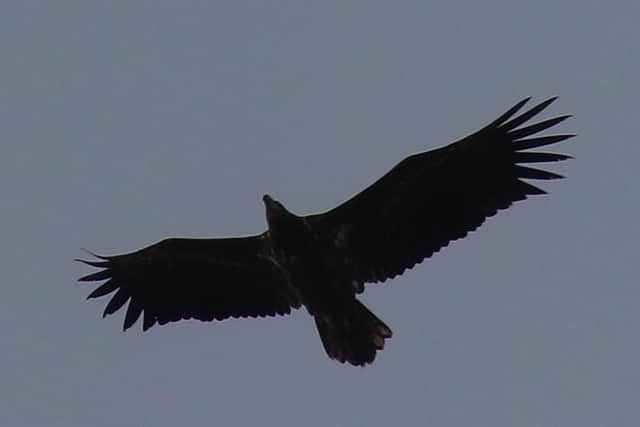Volunteers stunned as two white-tailed eagles visit RSPB Bempton Cliffs nature reserve
The birds - also known as sea eagles - appeared at the nature reserve on March 30 and flew over in front of amazed onlookers.
They are the largest raptor resident in Britain, with a wingspan of around 8ft. A third individual was seen in the area in the winter.
Advertisement
Hide AdAdvertisement
Hide AdSea eagles were persecuted to extinction by 1918, when the last native bird was shot in the Shetland Isles, and only the occasional stray bird from Europe was seen in England until 2019, when the wildlife charity Roy Dennis Foundation began a reintroduction project on the Isle of Wight.


Two of the juveniles released on the Solent subsequently roamed in the spring and summer of 2020, spending a significant amoung of times roosting in the North York Moors National Park, where they fed on rabbits. The satellite-tracked birds also made brief stops in other parts of Yorkshire, but were not recorded at Bempton Cliffs, with the only visit to the coast last year being an exploratory flight to Loftus, near Whitby, by the young male.
RSPB staff say the eagles' origins are a mystery, as they are not tagged or ringed and have not come from the Isle of Wight programme.
Experts believe they may be roaming 'teenage' birds from a population in Europe, though it may be difficult to establish exactly where they came from.
Advertisement
Hide AdAdvertisement
Hide AdBempton Cliffs site manager Dave O'Hara said: "These sightings are more than we've ever had before. We're certain the birds aren't from the Isle of Wight, so it's a bit of a mystery. There has been some conjecture that strong easterly winds have blown them over from Europe. The Scottish birds don't often come down to England, so it seems most likely that they've crossed the North Sea.
"They are unlikely to stay, as they are young birds who roam and wander - but it could be a sign that they are looking for new locations."
Linda MacKenzie, a volunteer who was on the viewing platform at the time, said: “I couldn’t quite believe it - it was so exciting to see these two majestic birds but trying to keep track of both was tricky. I didn’t catch sight of the black-browed albatross that visited the cliffs last year, however this was almost as good”.
Another volunteer, Ian Crossley, photographed the pair.
The RSPB became involved in a long-term plan to reintroduce the species to Scotland in the 1970s and initially a number of young Norwegian birds were released on Rum, in the Inner Hebrides.
Over the years, further releases took place and there are now thought to be around 40 pairs north of the border.
However, the species remains on the endangered Red List as it is slow to breed.
Comment Guidelines
National World encourages reader discussion on our stories. User feedback, insights and back-and-forth exchanges add a rich layer of context to reporting. Please review our Community Guidelines before commenting.